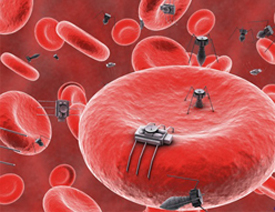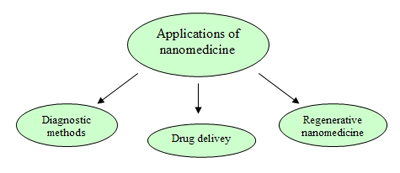The application of nanotechnology in the healthcare field has enabled the development of a new scientific discipline known as nanomedicine.
Due to the fact that some of the fundamental biological macromolecules of living organisms (like the DNA and proteins) are located at nanoscale, this has allowed the interaction between nanometric devices and nanomaterials within the human body. This has facilitated the discovery of important new advances in medicine.
Certain predictions made in the early stages of the development of nanotechnology are still science fiction.
For instance, the idea that we could develop “nanobots” that would protect us against external microorganisms, would cure injuries and damaged tissues selectively. Nevertheless, some major advances have been made.
For instance, the idea that we could develop “nanobots” that would protect us against external microorganisms, would cure injuries and damaged tissues selectively. Nevertheless, some major advances have been made.
The steady increase of neurodegenerative and cardiovascular diseases, diabetes or cancer requires us to investigate new diagnostic and therapeutic techniques that must be simpler, quicker and more precise than the ones we have today, decreasing, at the same time, the costs involved. It is expected that nanomedicine should address some of these problems, like diagnosing disease at its earliest stage, tailored treatments for patients or the ability to regenerate damaged organs and tissues.
Nanomedicine is focused on three large areas: diagnostic methods, drug delivery systems and regenerative medicine. Nanodiagnostic techniques are divided into analysis systems and methods of medical imaging. Both methods enable the detection of the appearance of the disease, in vitro and in vivo at early stages. This makes it possible to take action with the most appropiate treatment and causing as little damage as possible to the rest of the body.
In sample analysis of patients, nanomedicine also helps to achieve a more specific, quicker and more effective diagnosis. In this way diseases are diagnosed at cellular and molecular level providing more chance of a cure.
Nanomedicine has also advanced drug delivery systems: drugs are guided specifically to those affected areas and cells to accomplish a more effective treatment with a lower dose and minimising side effects. In addition, these systems protect the carried drug by avoiding degradation of the drug before it reaches its target. Thus, the challenges of delivery associated with drugs with poor solubility or with those that cannot be delivered using conventional methods is solved.
Lastly, through gene and cell therapies, biomaterials, tissue engineering and nanotech tools, regenerative nanomedicine boosts the natural repairing mechanisms of the human body which often are not enough to achieve the total recovery of the organism alone.
Nanomedicine has also advanced drug delivery systems: drugs are guided specifically to those affected areas and cells to accomplish a more effective treatment with a lower dose and minimising side effects. In addition, these systems protect the carried drug by avoiding degradation of the drug before it reaches its target. Thus, the challenges of delivery associated with drugs with poor solubility or with those that cannot be delivered using conventional methods is solved.
Lastly, through gene and cell therapies, biomaterials, tissue engineering and nanotech tools, regenerative nanomedicine boosts the natural repairing mechanisms of the human body which often are not enough to achieve the total recovery of the organism alone.
Sources: Informe de vigilancia tecnológica: nanomedicina. Fundación para el conocimiento madri+d CEIM
Nanomedicina: aplicación de la nanotecnología en la salud. Laura M. Lechuga.Grupo de Nanobiosensores y Aplicaciones Bioanalíticas
Centro de Investigación en Nanociencia y Nanotecnología (CIN2). CSIC
Fundación española para la ciencia y la tecnología (FECYT). Nanociencia y nanotecnología. Entre la ciencia ficción del presente y la tecnología del futuro, 2009.
Nanomedicina: aplicación de la nanotecnología en la salud. Laura M. Lechuga.Grupo de Nanobiosensores y Aplicaciones Bioanalíticas
Centro de Investigación en Nanociencia y Nanotecnología (CIN2). CSIC
Fundación española para la ciencia y la tecnología (FECYT). Nanociencia y nanotecnología. Entre la ciencia ficción del presente y la tecnología del futuro, 2009.







Your opinion matters